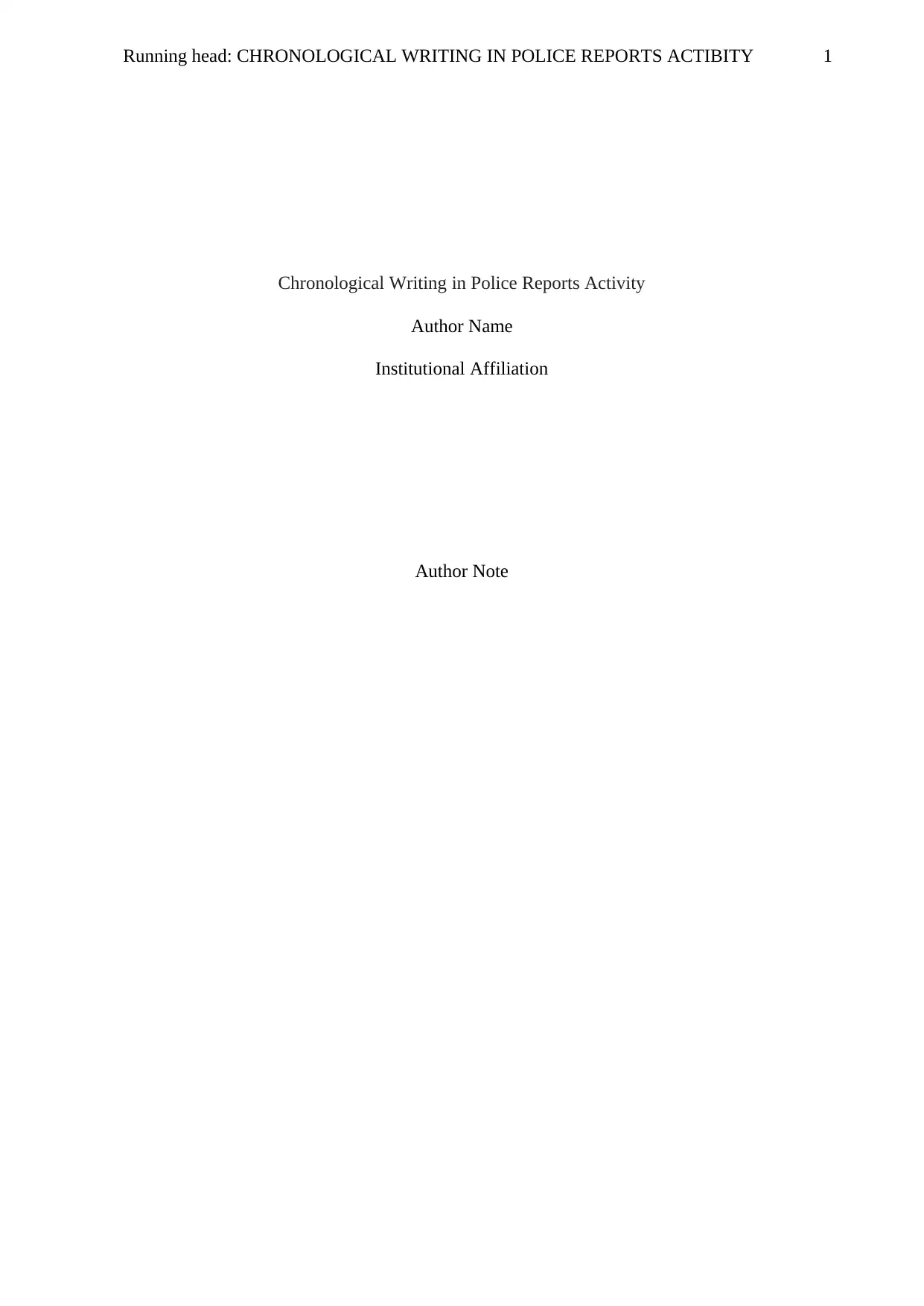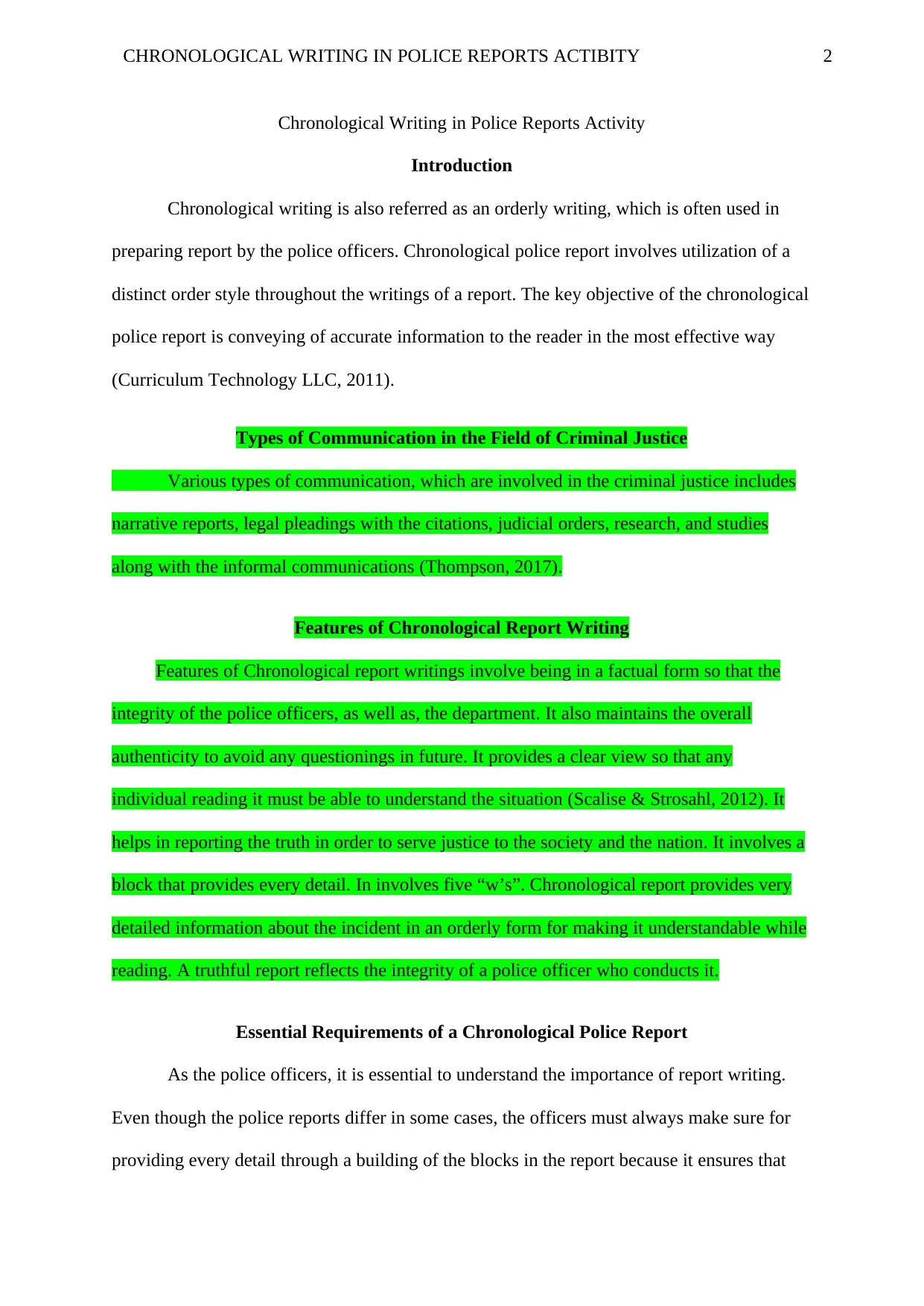Activity: Mastering Chronological Writing in Police Reports
VerifiedAdded on 2023/06/15
|5
|877
|208
Report
AI Summary
This report examines chronological writing in police reports, emphasizing its importance in conveying accurate information effectively. It identifies various communication types in criminal justice, outlines the features of chronological report writing, and details the essential requirements for police officers to ensure comprehensive and orderly reporting. The report stresses the need for factual accuracy, clarity, and thoroughness, covering the who, what, when, where, why, and how of incidents. By adhering to a proper chronological order, officers can uphold integrity, serve justice, and maintain detailed records, benefiting both the victim and the law enforcement agency. The paper serves as a guide for newly recruited officers, highlighting the significance of meticulous report writing in their service to society and the nation. Desklib provides access to this and other solved assignments.

1Running head: CHRONOLOGICAL WRITING IN POLICE REPORTS ACTIBITY
Chronological Writing in Police Reports Activity
Author Name
Institutional Affiliation
Author Note
Chronological Writing in Police Reports Activity
Author Name
Institutional Affiliation
Author Note
Paraphrase This Document
Need a fresh take? Get an instant paraphrase of this document with our AI Paraphraser

2CHRONOLOGICAL WRITING IN POLICE REPORTS ACTIBITY
Chronological Writing in Police Reports Activity
Introduction
Chronological writing is also referred as an orderly writing, which is often used in
preparing report by the police officers. Chronological police report involves utilization of a
distinct order style throughout the writings of a report. The key objective of the chronological
police report is conveying of accurate information to the reader in the most effective way
(Curriculum Technology LLC, 2011).
Types of Communication in the Field of Criminal Justice
Various types of communication, which are involved in the criminal justice includes
narrative reports, legal pleadings with the citations, judicial orders, research, and studies
along with the informal communications (Thompson, 2017).
Features of Chronological Report Writing
Features of Chronological report writings involve being in a factual form so that the
integrity of the police officers, as well as, the department. It also maintains the overall
authenticity to avoid any questionings in future. It provides a clear view so that any
individual reading it must be able to understand the situation (Scalise & Strosahl, 2012). It
helps in reporting the truth in order to serve justice to the society and the nation. It involves a
block that provides every detail. In involves five “w’s”. Chronological report provides very
detailed information about the incident in an orderly form for making it understandable while
reading. A truthful report reflects the integrity of a police officer who conducts it.
Essential Requirements of a Chronological Police Report
As the police officers, it is essential to understand the importance of report writing.
Even though the police reports differ in some cases, the officers must always make sure for
providing every detail through a building of the blocks in the report because it ensures that
Chronological Writing in Police Reports Activity
Introduction
Chronological writing is also referred as an orderly writing, which is often used in
preparing report by the police officers. Chronological police report involves utilization of a
distinct order style throughout the writings of a report. The key objective of the chronological
police report is conveying of accurate information to the reader in the most effective way
(Curriculum Technology LLC, 2011).
Types of Communication in the Field of Criminal Justice
Various types of communication, which are involved in the criminal justice includes
narrative reports, legal pleadings with the citations, judicial orders, research, and studies
along with the informal communications (Thompson, 2017).
Features of Chronological Report Writing
Features of Chronological report writings involve being in a factual form so that the
integrity of the police officers, as well as, the department. It also maintains the overall
authenticity to avoid any questionings in future. It provides a clear view so that any
individual reading it must be able to understand the situation (Scalise & Strosahl, 2012). It
helps in reporting the truth in order to serve justice to the society and the nation. It involves a
block that provides every detail. In involves five “w’s”. Chronological report provides very
detailed information about the incident in an orderly form for making it understandable while
reading. A truthful report reflects the integrity of a police officer who conducts it.
Essential Requirements of a Chronological Police Report
As the police officers, it is essential to understand the importance of report writing.
Even though the police reports differ in some cases, the officers must always make sure for
providing every detail through a building of the blocks in the report because it ensures that

3CHRONOLOGICAL WRITING IN POLICE REPORTS ACTIBITY
the police offers covers who, what, when, where, why, and how in every written report based
on the incident. At times of interpersonal and written communication, explanation of five
“w’s” and “h” must be clearly mentioned as these states “who” is broader than the crime
committed. These assists in answering the questions in details, which further helps in
identifying the party, who made the complaint along with the victim and suspect including
witness, as well, as any law enforcers involved in the cases.
Thus, the police officers at the time of the identifying the address of the workplace
and home needs to be noted down. In addition, it is also essential to report on individual’s
physique and telephone number, as well as, occupation is mandatory. Police officers must
always cover detailed information on the queries regarding the type of crime committed.
These queries can be identifying of what type of evidence was obtained, along with the
knowing of what happened with the evidence. Furthermore, a police officer also needs to
report on which agency had received the call and the officers, who were in the pursuit of the
case or incident. Questions involving “when” is more important, as it can help in making
conversation or interrogation with the involved individuals. After the officer answers these
questions, it is essential for them go through observations of the crime scene and further
involving queries. Once the police officer collects all the necessary requirements, different
information should be arranged orderly so that the reader gets a clear understanding in an
orderly manner. Since different reports are read by the different readers, information should
be stated with a proper heading so it can help in maintaining adequate records of the crime
reported (Kleine, 2004).
Conclusion
Following the exact and proper chronological order in police report writing, an officer
can help to serve justice on behalf of the victim. It further reflects the integrity of the police
officers, as well as, the police department. This paper establishes a clear understanding of
the police offers covers who, what, when, where, why, and how in every written report based
on the incident. At times of interpersonal and written communication, explanation of five
“w’s” and “h” must be clearly mentioned as these states “who” is broader than the crime
committed. These assists in answering the questions in details, which further helps in
identifying the party, who made the complaint along with the victim and suspect including
witness, as well, as any law enforcers involved in the cases.
Thus, the police officers at the time of the identifying the address of the workplace
and home needs to be noted down. In addition, it is also essential to report on individual’s
physique and telephone number, as well as, occupation is mandatory. Police officers must
always cover detailed information on the queries regarding the type of crime committed.
These queries can be identifying of what type of evidence was obtained, along with the
knowing of what happened with the evidence. Furthermore, a police officer also needs to
report on which agency had received the call and the officers, who were in the pursuit of the
case or incident. Questions involving “when” is more important, as it can help in making
conversation or interrogation with the involved individuals. After the officer answers these
questions, it is essential for them go through observations of the crime scene and further
involving queries. Once the police officer collects all the necessary requirements, different
information should be arranged orderly so that the reader gets a clear understanding in an
orderly manner. Since different reports are read by the different readers, information should
be stated with a proper heading so it can help in maintaining adequate records of the crime
reported (Kleine, 2004).
Conclusion
Following the exact and proper chronological order in police report writing, an officer
can help to serve justice on behalf of the victim. It further reflects the integrity of the police
officers, as well as, the police department. This paper establishes a clear understanding of
⊘ This is a preview!⊘
Do you want full access?
Subscribe today to unlock all pages.

Trusted by 1+ million students worldwide

4CHRONOLOGICAL WRITING IN POLICE REPORTS ACTIBITY
how a proper report should be conducted to the newly recruited officers if they are to serve
for themselves, the society and the nation.
how a proper report should be conducted to the newly recruited officers if they are to serve
for themselves, the society and the nation.
Paraphrase This Document
Need a fresh take? Get an instant paraphrase of this document with our AI Paraphraser

5CHRONOLOGICAL WRITING IN POLICE REPORTS ACTIBITY
References
Curriculum Technology LLC. (2011). Report writing activities for the criminal justice
student. A Supplement to Curriculum Technology’s, 1-15.
Kleine, M. (2004). Criminal justice institute. School of Law Enforcement Supervision, 1-19.
Scalise, F. & Strosahl, D. (2012). A street officer's guide to report writing. USA: Cengage
Learning.
Thompson, V. (2017). Types of communication in criminal justice. Retrieved from
https://careertrend.com/info-8357549-types-communication-criminal-justice.html
References
Curriculum Technology LLC. (2011). Report writing activities for the criminal justice
student. A Supplement to Curriculum Technology’s, 1-15.
Kleine, M. (2004). Criminal justice institute. School of Law Enforcement Supervision, 1-19.
Scalise, F. & Strosahl, D. (2012). A street officer's guide to report writing. USA: Cengage
Learning.
Thompson, V. (2017). Types of communication in criminal justice. Retrieved from
https://careertrend.com/info-8357549-types-communication-criminal-justice.html
1 out of 5
Related Documents
Your All-in-One AI-Powered Toolkit for Academic Success.
+13062052269
info@desklib.com
Available 24*7 on WhatsApp / Email
![[object Object]](/_next/static/media/star-bottom.7253800d.svg)
Unlock your academic potential
Copyright © 2020–2025 A2Z Services. All Rights Reserved. Developed and managed by ZUCOL.





